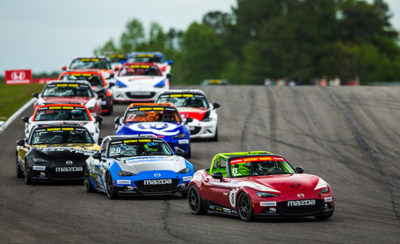The tech inspection at a MX-5 Cup race is pretty thorough to make sure that not only is one car not better than the rest, but also that no car is worse
The vast majority of racers want a fair contest, and a big part of that in racing is making sure everyone is playing by the same rules. When it comes to the mechanical equipment, that is verified by the tech inspection process. In the Idemitsu MX-5 Cup Presented by BFGoodrich® Tires, the process is overseen by the series tech manager Jay Mauney.
“I basically have a six-part process that everyone goes through,” Mauney explains. “Our first priority is safety, then parity. When we get to the track, we run through every single car looking at safety issues. But then there are six other processes that we run through.”
The first thing they look at is the General Engine Management Systems ECU, which is locked down tight so competitors can’t tamper with it. There are multiple internal locks and intrusion identification measures that are verified at each event to be untampered with.
It’s the data inside the GEMS ECU that really provides good insight into what’s happening with the cars and, after every session, the series is going to pull data from five or 10 cars and go through it. That data will reveal everything that happens with the engine – temperatures, RPMs, lambda and codes, among other things.
“We’re looking for knowledge,” explains Mauney. “Any difference between one car and another, no matter how insignificant it is, the data is going to show it, that this car is two degrees hotter or that one’s cooler. We take any difference as a clue to look deeper and see what might be happening. We’ve actually had experiences where we’ve done testing and let a competitor know that his engine performance is down and it’s time to get a new engine in the car. It goes both ways – the parity could keep cars not only from being better, but also from being worse. It’s a two-sided coin that benefits the competitor in ways that sometimes they don’t think about.”
Next comes a visual inspection. There are a lot of tamper-proof seals on the car, and sometimes the series will announce that every car has to be up on jack stands in the paddock, so that all those seals can be inspected.
“The next thing we would look at will be to inspect all the homologated parts,” he says. “Each car has the same components, the same parts. We’re going to look at individual components. Even the shock has a seal on it. The seal is there to make sure nobody even makes an effort, but the neat thing about those shocks is that there are no aftermarket components available. The manufacturer does not make any additional valving, so even if you were somehow able to get into that shock and try to make some changes, you’d have to be a shock company to succeed.” And if something doesn’t look right, there’s a shock dyno on site to make sure everything is correct.
The inspection continues, even to using a durometer to check the bushings. Then comes fluid analysis, where Mauney says his team will check viscosity and do fuel testing, including color, specific gravity and even full spectrum analysis.
Mauney, the tech team, Andersen Promotions and IndyCar will also use the assistance of series partners such as AiM, Long Road Racing and BFGoodrich® Tires, something we’ll explore more in a future installment. But through all this, what Mauney and his team are finding is that the cars remain quite equal.
“It’s such a great package that we don’t find anomalies very often,” he says. “And most of the time I’ll dig into it and find a variable that causes the anomaly. When you have six lead changes on the final lap, it’s a pretty good sign that the vehicles are all the same.”


 ACCESSIBILITY
ACCESSIBILITY